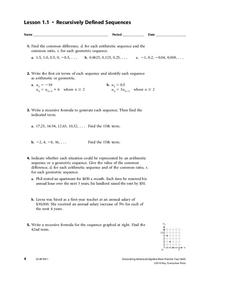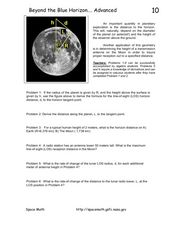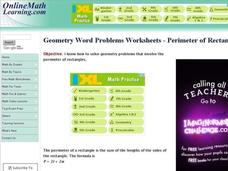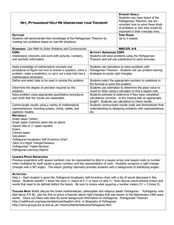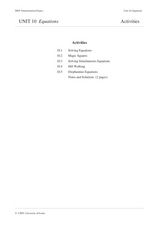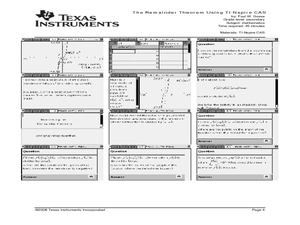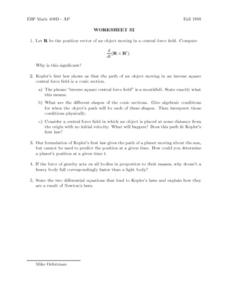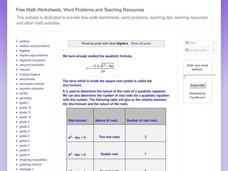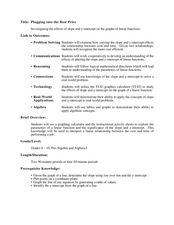EngageNY
Modeling with Quadratic Functions (part 2)
How many points are needed to define a unique parabola? Individuals work with data to answer this question. Ultimately, they determine the quadratic model when given three points. The concept is applied to data from a dropped...
Curated OER
Recursively Defined Sequesnces
In this algebra worksheet, learners solve a pattern or sequence using geometric and arithmetic formulas. There are 21 questions on 5 different sections.
Curated OER
Miami Metrozoo & Mathematics
Twelfth graders use Algebra and Geometry to solve a real life problem at the Zoo.
Curated OER
Beyond the Blue Horizon...Advanced
In this calculating the horizon instructional activity, students solve 6 problems using algebra, derivatives and calculus to find the formula for the line-of-sight horizon, the distance along a planet, the horizon distance and the rates...
Curated OER
Geometric Sequences and Series
Learn to calculate the nth term of a sequence defined by an algebraic expression. They examine geometric sequences and series, relate geometric sequences to their explicit forms, find the partial sums of a sequence in a table, and...
Curated OER
Geometry Word Problems-Perimeter of Rectangles
In this geometry instructional activity, 10th graders use algebra to solve geometry word problems involving the perimeter of a rectangle. The one page interactive instructional activity contains eight questions. Answers and hints are...
Curated OER
Algebra: Linear Equations
Students explore the concept of linear equations. For this linear equations lesson, students examine graphic organizers on steps to solve linear equations. Students then practice solving linear equations as they play a math game.
Curated OER
Formulas
In this algebra worksheet, students plot points in order to find the slope, midpoint, or distance between two points. There are 16 questions.
Curated OER
Supplemental Algebra Problems
In this volume worksheet, students compute the volume of geometric shapes. Each problem is an application (or word) problem. Students are given the appropriate formula and dimensions of the shape. Two problems ask about surface area.
EngageNY
Arithmetic and Geometric Sequences
Arithmetic and geometric sequences are linear and geometric patterns. Help pupils understand the relationship and see the connection with an activity that asks them to write the rules and classify the patterns correctly. A sorting...
Illustrative Mathematics
Oakland Coliseum
Help algebra learners relate a real-life function that happens at the Oakland Coliseum every time the Raiders play. The resource states that the revenue of the Oakland Raiders home games is a function of the number of seats sold and the...
Curated OER
Perfumania
Students identify various geometric shapes. Apply the given formulas to determine the volume of these shapes. Design their own container to conform to specifications provided. Use their knowledge of volume formulas and shapes to compute...
Curated OER
Hey, Pythagoras! Help Me Understand Your Theorem!
Learners explore the Pythagorean Theorem. In this math lesson, pupils solve problems using the Pythagorean Theorem. They select the appropriate numbers to substitute in the formula to solve problems.
Curated OER
Magic Squares, Simultaneous Equations, Hill Walking, and Diophantine Equations
In this solving equations worksheet, 9th graders solve and complete 21 various types of problems. First, they use the method shown to find the value of xin each equation. Then, students use an algebraic approach to solve the magic...
Curated OER
The Remainder Theorem Using TI-Nspire CAS
Investigate the Remainder Theorem in this algebra instructional activity. Explore the relationship between the remainders of polynomial division and the function. Each of the four problems gets progressively more complicated. This might...
Curated OER
Linear and Exponential Functions
This comprehensive unit on linear and exponential functions provides numerous clearly-written worksheets. Topics include graphing linear equations, solving systems of equations algebraically and by graphing, identifying the domain and...
For the Teachers
$1 Math
Captivate your class by having them find the value of their names, different zoo animals, musical instruments, etc.,with a mental math lesson. Using the coding formula listed, children learn to fluently estimate and calculate...
Curated OER
Worksheet 32: Kepler's Law
For this math worksheet, young scholars are given 8 questions regarding Kepler's first law of motion. The questions include definitions, short essay explanations, and formulaic expressions.
Curated OER
Integrated Algebra/Math B Regents Questions: Exponential Equations
In this exponential equations activity, students solve 11 word problems in short answer and multiple choice format. Students write and solve exponential growth and decay problems given a word problem.
Balanced Assessment
Local and Global Behavior
Create rules for numerical sequences. Pupils develop local rules and recursive rules for number sequences. The sequences are linear, quadratic, and cubic in nature. Scholars find that some local rules do not work, no matter where in...
Flipped Math
Slopes of Parallel and Perpendicular Lines
Apply slopes and not slipping. Learners discover the relationship between slopes of parallel and perpendicular lines. Individuals use that information to find equations of lines through a given point that is either parallel or...
Curated OER
Quadratic equations
In this Algebra II worksheet, 11th graders use the quadratic formula to solve quadratic equations. The interactive lesson contains explanation and worked examples with five practice problems. Answers are not included.
Curated OER
Graphing on the Coordinate Plane
For this geometry worksheet, 10th graders determine the midpoint of a line segment given the coordinates of the two endpoints or find the missing endpoint given the coordinates of the midpoint and one endpoint. The one page...
Curated OER
Plugging Into The Best Price
Examine data and graph solutions on a coordinate plane with this algebra lesson. Young problem-solvers identify the effect of the slope on the steepness of the line. They use the TI to graph and analyze linear equations.

